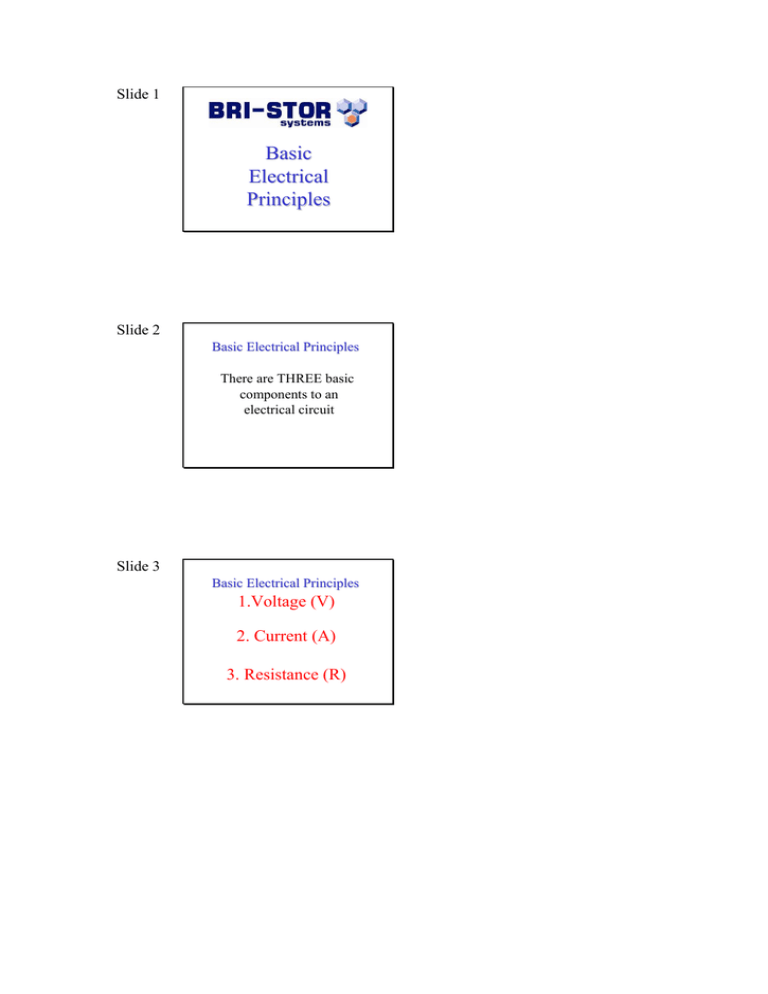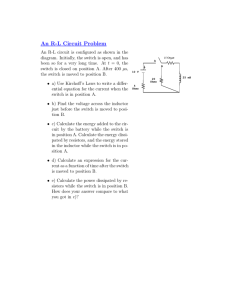Basic Electrical Principles
advertisement

Slide 1 Basic Electrical Principles Slide 2 Basic Electrical Principles There are THREE basic components to an electrical circuit Slide 3 Basic Electrical Principles 1.Voltage (V) 2. Current (A) 3. Resistance (R) Slide 4 Basic Electrical Principles 1.Voltage (V) Explain difference between mains and direct voltage. (Measured in Volts) Force used to push current around a circuit This can be A.C. (Alternating Voltage [Mains]) Or D.C. (Direct Voltage [Battery]) Slide 5 Basic Electrical Principles 2. Current (A) (Measured in Amps) The flow of electrons around a Circuit. This can be A.C. (Alternating Current [Mains]) Or D.C. (Direct Current [Battery]) Slide 6 Basic Electrical Principles 3. Resistance (R) (Measured in Ohms [Ω]) This is the resistance to current flow that all things have. Some are very low – Copper Wire (Conductors) Give example of Conductors, ask for suggestions of other possible conductors. Most metals, silicon (transistors), water. Slide 7 Basic Electrical Principles 3. Resistance (R) (Measured in Ohms[Ω]) This is the resistance to current flow that all things have. Some are very low – Copper Wire (Conductors) Some are very high – Plastic (Insulators) Give examples of Inulators, plastic sleeving, rubber, ask for suggestions of other possible insulators. Glass, wood, textiles, paper/cardboard. Slide 8 Basic Electrical Principles Ohms Law Ohms law states that the current through a conductor between two points is directly proportional to the potential difference across the two points. Slide 9 Basic Electrical Principles Power (W) (Measured in Watts) Power is the rate at which electrical energy is transferred by an electrical circuit i.e. how quickly it uses power Or ‘how long the battery lasts’ Bi-product of an electrical circuit Can be ‘felt’ as heat and is how devices are described, 60W bulb, 2.5KW fire etc. Slide 10 Basic Electrical Principles Power Calculation (Measured in Watts) Power (W) = Voltage (V) x Current (A) or Slide 11 Basic Electrical Principles Fuses Fuses are used to protect the circuit. They protect the cable from too much current being allowed to flow & protect the device from damage if it goes into fault. Slide 12 Basic Electrical Principles Fuse Calculation To calculate the correct fuse we use Ohms Law but because often we do not know the resistance then we can use the power formula: Show different types of fuse we normally use, Blade, Maxi and Mega. Slide 13 Basic Electrical Principles Fuse Calculation To calculate the correct fuse we use Ohms Law but because often we do not know the resistance then we can substitute power so becomes Slide 14 Basic Electrical Principles Fuse Calculation Therefore if we have a 48W worklight and it is Fitted on a 12v vehicle: Slide 15 Basic Electrical Principles Cable Types There are two types of cable: Stranded core – Vehicles & flexible cables (toaster, irons, tv etc) Show samples of cables used. Slide 16 Basic Electrical Principles Show sample of solid core cable. Cable Types There are two types of cable: Stranded core – Vehicles & flexible cables (toaster, irons, tv etc) Solid core – Mains installations Slide 17 Basic Electrical Principles Cable Colours Cable colours are mostly optional except for regulated installations. Solid & Striped for example: IEE 17th Edition Wiring Regulations Earth Cable MUST BE Green/ Green/Yellow Show samples of cables with different colours and stripes.
